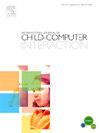A systematic review on design-based nudges for adolescent online safety
Q1 Social Sciences
International Journal of Child-Computer Interaction
Pub Date : 2024-11-28
DOI:10.1016/j.ijcci.2024.100702
引用次数: 0
Abstract
Within the realm of digital spaces, much of the nudging research has focused on general populations, which may not be applicable to nudges for adolescents, as minors are often more vulnerable to online risks and have unique developmental needs. To address this gap, we conducted a systematic literature review of 52 articles from the past 15 years that focused on technology-mediated nudges for teens’ online safety. We found that most nudges were designed for protecting teens as victims of cyberbullying in public settings, with recent trends towards studying nudges for diverse risk types and perspectives (e.g., risk perpetrators and bystanders). Most of the nudges were designed to be triggered during or after the risk occurrence, with fewer preventative approaches. Expanding upon Caraban et al.’s nudging framework, we found that commonly used mechanisms for nudges facilitated alternate actions or education, confronted youth with the consequences of risks, or involved parents. Lastly, most of the work focused on formative understanding or designing nudges for adolescents, with fewer ecologically valid evaluations of these nudges. We recommend building context-aware nudges with positive framing that can provide personalized guidance to help teens build resilience. We call for further investigation into how nudges can effectively empower adolescents in different cultural contextsby supporting autonomy and collective safety, while also confronting perpetrators and societal challenges for improved online safety outcomes. Finally, we provide guidelines to move towards realistic evaluations of nudges, and to engage with teens at every stage; from design to evaluations of online safety nudges.
基于设计的青少年网络安全督促的系统回顾
在数字空间领域,许多关于“轻推”的研究都集中在普通人群身上,这可能不适用于青少年,因为未成年人往往更容易受到网络风险的影响,而且有独特的发展需求。为了解决这一差距,我们对过去15年的52篇文章进行了系统的文献回顾,这些文章主要关注技术对青少年在线安全的推动。我们发现,大多数轻推都是为了保护青少年在公共环境中成为网络欺凌的受害者而设计的,最近的趋势是研究不同风险类型和视角(例如,风险肇事者和旁观者)的轻推。大多数的助推被设计为在风险发生期间或之后触发,预防性措施较少。在Caraban等人的推动框架的基础上,我们发现,通常使用的推动机制促进了替代行动或教育,使青少年面临风险的后果,或使父母参与其中。最后,大多数工作集中在形成性理解或为青少年设计推动,对这些推动的生态有效评估较少。我们建议建立积极框架的情境感知推动,可以提供个性化的指导,帮助青少年建立弹性。我们呼吁进一步研究轻推如何通过支持自主和集体安全,有效地赋予不同文化背景下的青少年权力,同时应对肇事者和社会挑战,以改善网络安全结果。最后,我们提供了指导方针,以实现对轻推的现实评估,并在每个阶段与青少年接触;从设计到评估在线安全提示。
本文章由计算机程序翻译,如有差异,请以英文原文为准。
求助全文
约1分钟内获得全文
求助全文
来源期刊

International Journal of Child-Computer Interaction
Social Sciences-Education
CiteScore
7.20
自引率
0.00%
发文量
73
 求助内容:
求助内容: 应助结果提醒方式:
应助结果提醒方式:


